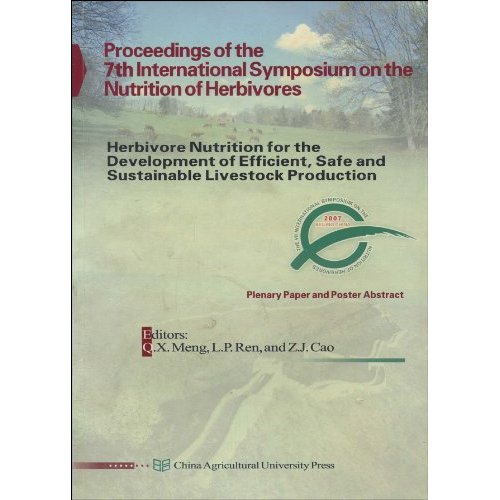
包邮第七届食动物营养国际学术研讨会论文集

温馨提示:5折以下图书主要为出版社尾货,大部分为全新(有塑封/无塑封),个别图书品相8-9成新、切口有划线标记、光盘等附件不全详细品相说明>>
- ISBN:7811172577
- 装帧:一般胶版纸
- 册数:暂无
- 重量:暂无
- 开本:16
- 页数:603 页
- 出版时间:2007-09-20
- 条形码:9787811172577 ; 978-7-81117-257-7
本书特色
《第七届草食动物营养国际学术研讨会文集》:Proceedings of the,7th International Symposium on the,Nutrition of Herbivores,Herbivore Nutrition for the,Development of Efficient, Safe,and Sustainable Livestock Production.
内容简介
简介 《第七届草食动物营养国际学术研讨会文集》:proceedings of the,7th international symposium on the,nutrition of herbivores,herbivore nutrition for the,development of efficient, safe,and sustainable livestock production.
目录
节选
《第七届草食动物营养国际学术研讨会文集》 is my pleasure to welcome you to The Seventh International Symposium on the Nutrition of Herbivores (ISNH-7). The objectives of the International AdvisoryCommittee (IAC) are "to provide a forum for development, exchange and promotionof knowledge on the nutrition of terrestrial herbivores in captive and free-livingenvironments". Managing herbivores in commercial and wildlife systems is aboutmore than simply meeting nutrient requirements or manipulating production throughnutrition, important as that is. The meeting traverses a spectrum of research whichadvances the nutritional sciences through novel molecular approaches to problemswhile promoting their application in the management of the productivity and healthof herbivores and the mitigation their impact on the environment. Increasingly, thehuman health benefits and otherwise of animal food products are a consumerconcern and special recognition of the opportunities to enhance food quality throughanimal nutrition is a new feature of the scope of the plenary programme.In the current global environment herbivores, because of their unique digestivesystems, come under intense scrutiny for their "contribution to greenhouse" gases.What often goes unstated is their ability to harvest biomass otherwise unavailable asa human food source without inputs of fossil fuel an attribute which surely securestheir importance for the future well-being of mankind.The breadth of scientific expertise at this conference is a unique feature of theSymposium Series. Make the most of it, and enjoy the kindness and culture of ourhosts.In this volume, you can find the plenary papers and poster abstracts presented atISNH-7. The 6-page short papers have been published in the Journal of Animal Feedand Sciences, as special issue (Volume 16, Supplement 2, 2007).On behalf of the International Advisory Committee, we wish to thank TheChinese Association of Animal Science and Veterinary Medicine (CAAV) fororganizing this symposium in Beijing. The committee members also express theirspecial appreciation to Dr Qingxiang Meng and his colleagues at the ChinaAgricultural University to whom we are indebted for their magnificent work duringthe last 4 years in bringing this scientific programme and conference together. Finally, we wish to thank all the participants at the symposium for theircomments, questions and criticisms. Their input has resulted in significantimprovements in the papers presented in this symposium.
相关资料
插图:The growth rate of yaks generally is not constant from birth to slaughter, especiallyon the Qinghai-Tibet plateau where the annual nutrient supply of grassland variesgreatly with the season. In the first year of the spring-born yaks in Su-Nan County,the BW increased steadily until the first cold season (Figure 3 and Table 17). FromJanuary through May (winter through spring), BW decreased due to the severe coldof the winter/spring season, which produces temperatures that fall below yakthermo-neutrality, and a shortage of forage supply in spring. From May throughOctober (summer through autumn), BW again increased. The ADG of grazing yakduring this warm season was 0.42 kg/d, compared with the 0.25 kg/d reported byXue et al. (1994) for feedlot yak (weighed in morning before feeding) fed ahigh-concentrate diet. Grazing yak thus showed highly efficient compensatorygrowth relative to feedlot yak.Compensatory growth is the term coined by Bohman (1955) to describe theaccelerated or more efficient growth that commonly follows a period of growthrestriction. The effects of a previous plane of nutrition on subsequent growth ofdomestic livestock have been documented extensively (Wilson and Osbourn, 1960;Allden, 1970; Moran and Holmes, 1978). The phenomenon of compensatory growthis of considerable practical significance to grassland livestock production. Theefficacy of compensatory growth in a segmented production system is based on thedifferences in market value and growth efficiency between compensating andnon-compensating animals. In an integrated yak production system such as that onthe Qinghai-Tibet Plateau, actual input costs for each phase of production should beconsidered. Our data documenting the BW loss in grazing yak in the cold seasondemonstrated that the decline in BW during the first weight loss season consumed25.7% of the total BW accumulation of the first (preceding)
-

常见树木图鉴
¥14.0¥48.0 -

清代雍正时期的京畿水利营田
¥11.9¥32.0 -

20世纪中国科学口述史:农业科技“黄淮海战役”
¥23.5¥75.0 -

种菜关键技术121题
¥5.6¥17.0 -

中国畜禽种业发展报告2024
¥52.6¥120.0 -

农业科技翻译
¥28.6¥40.0 -

(高职高专)园艺植物研究法
¥72.1¥81.0 -
![见证百年草木华兹:绿植中的红色故事[彩图]](/Content/images/nopic.jpg)
见证百年草木华兹:绿植中的红色故事[彩图]
¥31.2¥48.0 -

蔬菜种植实用技术
¥21.6¥29.8 -

中国传统民俗文化:科技系列:中国古代农具
¥26.1¥58.0 -

蜈蚣养殖实用技术
¥12.0¥20.0 -

身边常见的600种树木识别速查图鉴
¥63.5¥88.0 -

北方清洁供暖透视
¥19.2¥48.0 -

向日葵遗传与育种
¥290.7¥368.0 -

黄河菌草生态治理
¥33.0¥68.0 -

家庭小菜园种植技术
¥5.8¥16.0 -

农民专业合作社知识问答
¥10.8¥20.0 -

宠物疾病防治
¥20.2¥40.0 -

园林树木学 第2版
¥44.4¥79.0 -

优质西甜瓜栽培技术
¥2.3¥3.0












